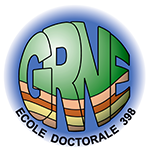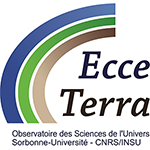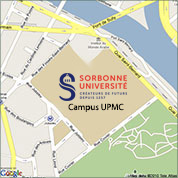Séminaire ISTeP - Cornelis "Kees" Weemstra
(ETHZ)
On the attenuation of the ambient seismic surface-wave fiel
Seismic interferometry by crosscorrelation refers to the principle of generating new seismic responses from existing recordings. A new response is reconstructed at the location of one receiver as if a source is present at the location of another receiver. The reconstructed response is an approximation of the Green’s function of the medium between the two receiver locations; the approximation is exact in case of a lossless medium illuminated uniformly from all directions. Applied to the ambient seismic noise field, the method has proven most successful in retrieving surface-wave responses. The reason is that ocean microseisms, the main source of ambient-seismic noise on Earth, excite surface waves much more effectively than other seismic phases.
Conventionally, the newly obtained responses are used to extract receiver-receiver phase velocities, which often serve as input parameter for tomographic inverse problems. More recently, the reconstructed responses have been used to estimate subsurface attenuation. It turns out that, under certain conditions, the Green’s function approximation can be extended to dissipative media.
I will give a short overview of seismic interferometry in general and briefly the underlying theory. Subsequently, I present a case study employing a data set consisting of relatively short broad-band Ocean Bottom Seismometer (OBS) recordings. The data set is the result of a seismic survey in the North Sea with an aperture of about 12 km. The main energy in the OBS data below ∼2Hz stems from swell noise and ocean microseisms. This energy is expressed as surface waves traveling along the seabed. We show that the decay of responses obtained from these ambient surface waves cannot be explained by geometrical spreading alone and requires an additional loss of energy with distance. We quantify the observed excess decay in the frequency domain and hence obtain frequency-dependent estimates of attenuation. The resulting quality factors as function of frequency are indicative of the depth variation of attenuation and correlate with the geology in the survey area.
12/03/2014 à 12h45, Salle Fourcade (Tour 55-56, 4ème étage)
Egalement dans la rubrique
Chiffres clés (Mars 2025)
L'ISTeP comprend 131 membres dont :
Permanents (66)
- Professeurs : 17 (+2 PAST)
- Maîtres de conférence : 26
- Directeurs de recherche CNRS : 1
- Chargés de recherche CNRS : 1
- ITA : 19
Personnels non permanents (65)
- Collaborateurs bénévoles / émérites : 17
- Chaire de professeur junior : 1
- Enseignants-chercheurs contractuel : 2
- 1 MCF accueil en délégation
- ATER et Post-Docs : 9
- Doctorants : 32
- ITA-BIATSS : 3





